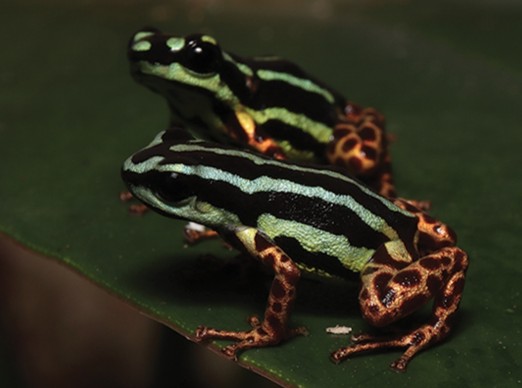There are gems to be found in the dense forests surrounding Brazil’s Juruá River Basin. Not the kind you’ll find on a piece of jewelry, though – these ones come in the form of a brand-new, teeny tiny, and super shiny species of poison dart frog.
When we say “super shiny”, we’re not kidding. These frogs sport a unique, metallic color pattern; their legs look almost leopard-like, with large, dark red-brown spots against a golden background. The dorsal part of their bodies, however, features alternating black and chrome blue-green stripes. The latter reminded the team that discovered the frogs of the color of seawater, and so it ended up inspiring the species’ name: Ranitomeya aquamarina.
We weren’t joking about the “teeny tiny” part either. These frogs are typically a little over 17 millimeters (0.67 inches) from the tip of their snouts to their rears – though the females are generally a little bigger than the males – meaning they’re about as long as a dime is wide. Not the smallest frog in the world, sure, but still adorably wee.
The researchers discovered something curious about the tiny, shiny frogs’ behavior, too: they appear to be monogamous. The reason this is unusual is that frogs are generally observed to be, well, croaky little philanderers. In fact, it wasn’t until 2010 that monogamy was seen in frogs (or any amphibian, for that matter) for the first time.
R. aquamarina, on the other hand, was mostly observed hanging out in couples. When the females in these couples were captured, their male partners called out for them “incessantly”, the researchers wrote. If your partner doesn’t miss you that much when you’re gone, dump them.

Couple goals.
The team also described the newly discovered poison dart frog as an “Amazonian hidden gem”. It was the first new species in this genus found in 13 years – and it might not be the only such gem hiding out there. According to the authors, the region where it was found is likely highly biodiverse, but is also one of the least sampled in the entire Amazon rainforest.
There are practical problems in carrying out research in the densely packed rainforest, but the team suggests their study is evidence that the rewards could be more than worth it.
“Although we are only taking the first steps to uncover the biodiversity of this area, we already have evidence of the extraordinary richness of the local fauna and we already identified many new candidate species,” the authors write.
“We hope that our research will stimulate more interest in this region, shed more light on its enormous biological wealth and, last but not least, provide important information for its protection.”
The study is published in ZooKeys.
Source Link: New, Adorably Tiny Species Of Metallic Poison Dart Frog Is “An Amazonian Hidden Gem”